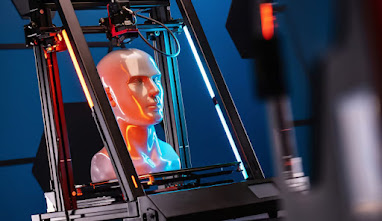3D printing is a process in which a digital model is turned into a tangible, solid, three-dimensional object, usually by laying down many successive, thin layers of a material. 3D printing has become popular so quickly because it makes manufacturing accessible to more people than ever before. This is partly due to the price (the starting price for a basic 3D printer is about $300), but also the small size of the printers compared to traditional manufacturing.
3D printing is an additive technology used to manufacture parts. It is ‘additive’ in that it doesn’t require a block of material or a mold to manufacture physical objects, it simply stacks and fuses layers of material. It’s typically fast, with low fixed setup costs, and can create more complex geometries than ‘traditional’ technologies, with an ever-expanding list of materials. It is used extensively in the engineering industry, particularly for prototyping and creating lightweight geometries.
How does it work?
First, a virtual design of the object is made. This design will work like a blueprint for the 3D printer to read. The virtual design is made using computer-aided design (CAD) software, a type of software that can create precise drawings and technical illustrations. A virtual design can also be made using a 3D scanner, which creates a copy of an existing object by basically taking pictures of it from different angles.
Once the virtual model is made, it must be prepared for printing. This is done by breaking down the model into many layers using a process called slicing. Slicing takes the model and slices it into hundreds or even thousands of thin, horizontal layers using special software.
After the model has been sliced, the slices are ready to be uploaded to the 3D printer. This is done using a USB cable or Wi-Fi connection to move the sliced model from the computer it’s on to the 3D printer. When the file is uploaded to the 3D printer, it reads every slice of the model and prints it layer by layer.
The different types of 3D printing
- Vat Polymerization: liquid photopolymer is cured by light
- Material Extrusion: molten thermoplastic is deposited through a heated nozzle
- Powder Bed Fusion: powder particles are fused by a high-energy source
- Material Jetting: droplets of liquid photosensitive fusing agent are deposited on a powder bed and cured by light
- Binder Jetting: droplets of liquid binding agent are deposited on a bed of granulated materials, which are later sintered together
- Direct Energy Deposition: molten metal simultaneously deposited and fused
- Sheet Lamination: individual sheets of material are cut to shape and laminated together
3D Printing Applications
1. Construction
Construction is one of the significant applications of 3D printing. Concrete 3D printing has been explored since the 1990s as researchers sought a faster and cheaper way to construct structures. Specific applications of 3D printing in construction include additive welding, powder bonding (reactive bond, polymer bond, sintering), and extrusion (foam, wax, cement/concrete, polymers).
2. Prototyping and manufacturing
In the case of traditional injection-molded prototyping, it can take weeks to produce a single mold that would cost up to hundreds of thousands of dollars. As established earlier in the article, the original purpose of 3D printing was faster and more efficient prototyping.
3D printing technology minimizes lead times in manufacturing, enabling prototyping to be completed within a few hours and at a small percentage of traditional costs. This makes it especially ideal for projects where users must upgrade the design with every iteration.
3D printing is also suitable for manufacturing products that do not need to be mass-produced or are usually customized. SLS and DMLS are used in the rapid manufacturing of final products, not just prototypes.
3. Healthcare
In healthcare, 3D printing creates prototypes for new product development in the medical and dental fields. In dentistry, 3D printing is also helpful in creating patterns for casting metal dental crowns and manufacturing tools for creating dental aligners.
The solution is also helpful for directly manufacturing knee and hip implants and other stock items and creating patient-specific items such as personalized prosthetics, hearing aids, and orthotic insoles. The possibility of 3D-printed surgical guides for particular operations and 3D-printed bone, skin, tissue, organs, and pharmaceuticals is being explored.
4. Aerospace
In aerospace, 3D printing is used for prototyping and product development. The solution is also critically helpful in aircraft development, as it helps researchers keep up with the strenuous requirements of R&D without compromising on the high industry standards. Certain non-critical or older aircraft components are 3D-printed for the flight!
5. Automotive
Automotive enterprises, especially those specializing in racing automobiles, such as those used in F1, leverage 3D printing for prototyping and manufacturing specific components. Organizations in this space are also exploring the possibility of using 3D printing to fulfill aftermarket demand by producing spare parts as customers require rather than stocking them up.






No comments:
Post a Comment